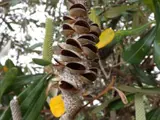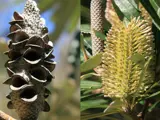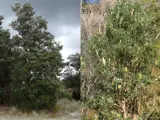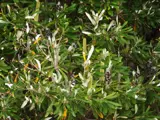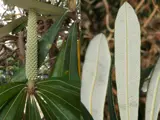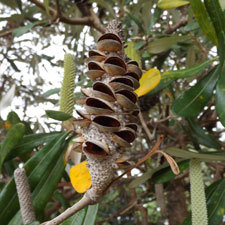 Coastal banksia
Coastal banksia
Common name: Coastal banksia
Botanical name: Banksia integrifolia
Management programme: Sustained control - Rule 5a applies
Originates from Queensland, Australia and was introduced to New Zealand for horticultural purposes. Naturalised in 1990 and is named after Sir Joseph Banks an English naturalist, botanist, and patron of the natural sciences who was on Cook's first voyage to New Zealand.
Why is it a pest?
Coastal banksia forms dense thickets in open areas. It is fast growing, rapidly maturing and produces a lot of seeds that are released as soon as they ripen in late summer. It threatens well drained sites, especially sand dunes.
Where is it found?
- It is tolerant of a wide range of habitats from estuaries and dunes to subalpine tussock.
- Generally found in coastal areas within 50km of the coast.
- Many seeds are produced and may require fire for germination.
- Spreads by seed fall and wind dispersal up to 300m from parent tree.
- Scattered in coastal Bay of Plenty.
What does it look like?
- Fast growing large shrub or small tree up to 15m high, with upright, cone shaped greenish-yellow inflorescences (flower heads) from March to April, that give rise to hard wooden cones with many seeds.
- Narrow, elliptic leaves, deep glossy green on upper with silvery felted undersides. Tough and leathery.
- Flower heads are 9-12cm long, erect, forming a broadly cylindrical cone, pale green or pale greenish-yellow.
- Individual flowers are very narrow and 10–15mm long, the long narrow petals rolling back on opening and become matted together.
- Flowers also produce nectar that is attractive to birds like the tūi. Flowers May to July.
What are the rules?
Sustained control
Sustained Control pests are well established in the region and preventing the spread is no longer a realistic objective. Management focuses on reducing general impacts of the pest. Landowners/occupiers are responsible for the control of these pest species on their land. Council may enforce control.
Under rule 5a of the RPMP landowners/occupiers must destroy this pest if required by a written direction from an authorised person unless a property specific pest management agreement has been agreed and signed between the occupier and the Council.
Criteria to meet Rule 5A include when the species is being actively managed by council, other agency and or community group, on an adjacent property. See the Regional Pest Management Plan 2020-2030 rules for Sustained control pests for more information.
How do you get rid of it?
Recommended:
- Pull small seedlings.
- Cut and paint stumps with herbicide gel.
- Drill and fill large trees with herbicide.
Site will need to be checked regularly for seedlings emerging.
CAUTION: When using any herbicide or pesticide, PLEASE READ THE LABEL THOROUGHLY to ensure that all instructions and directions for the purchase, use and storage of the product, are followed and adhered to.
Read more on pest control advice, information and regulations
Images

